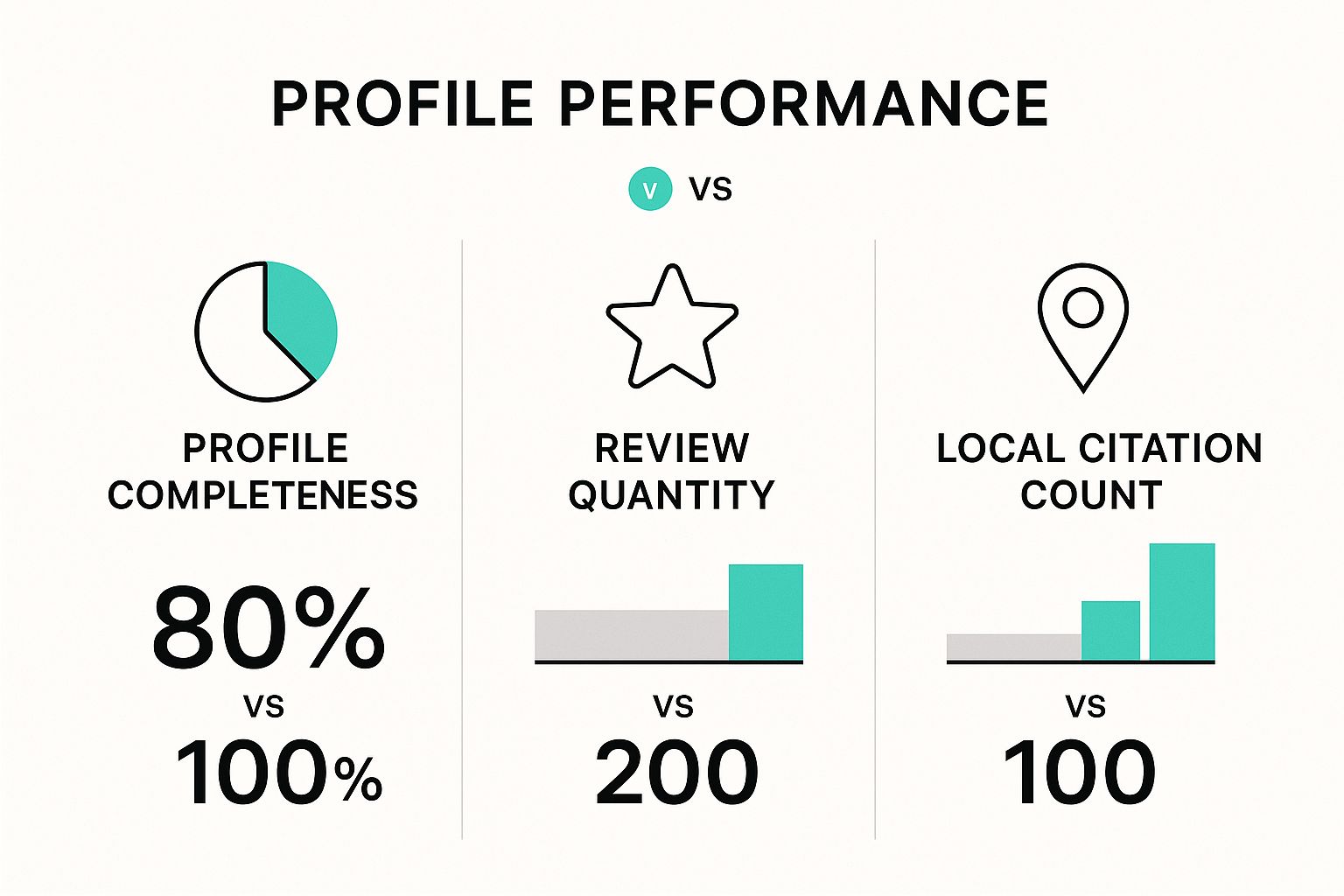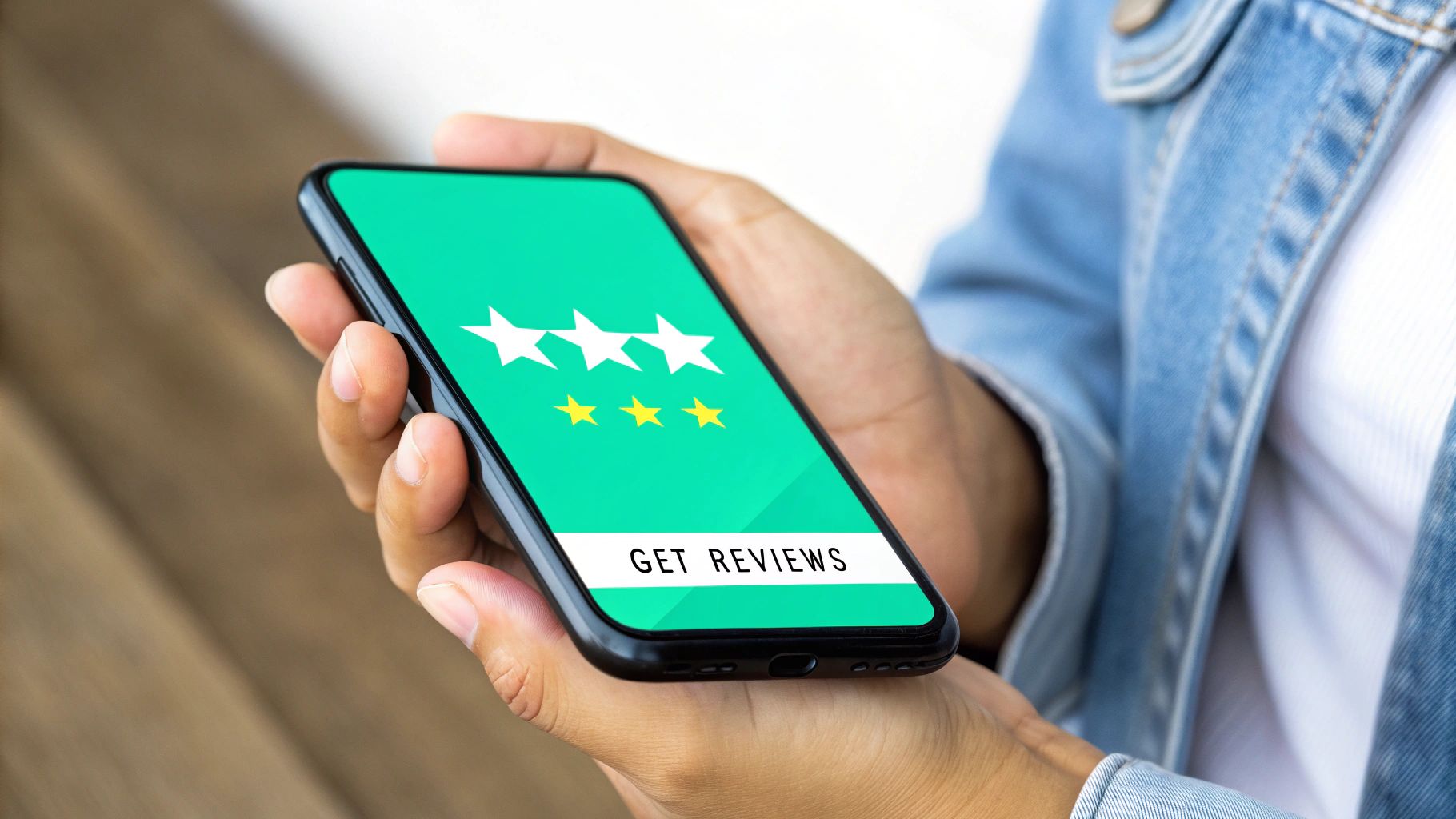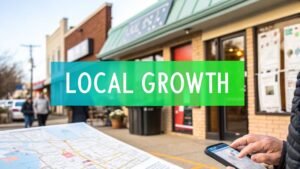Understanding What Really Drives Google Maps Rankings
Ranking higher on Google Maps isn't a matter of chance. It's about grasping the core principles behind Google's local algorithm. This means moving beyond the basics and zeroing in on the elements that truly influence your local search visibility. Think of it like constructing a building: a solid foundation is crucial before adding the walls and roof.
The Big Three: Distance, Relevance, and Prominence
Google identifies three key factors that affect local rankings: Distance, Relevance, and Prominence. Distance is how close your business is to the person searching. Relevance measures how well your business aligns with the user's search. Prominence reflects how well-known your business is, both online and in the real world.
Understanding these factors is crucial for businesses aiming to boost their Google Maps ranking. Optimizing your Google Business Profile (GBP) and using relevant local keywords are vital strategies for increasing relevance and prominence. This, in turn, leads to better visibility and customer engagement. Want a deeper dive into these factors? Check out this helpful resource: Google Local Ranking Factors
Visualizing the Impact of Key Factors
The infographic below illustrates the significant influence of profile completeness, review quantity, and local citation count on your Google Maps ranking. Each panel contrasts a lower value with a higher, optimized value, demonstrating the positive link between these factors and enhanced visibility.

As the infographic clearly shows, a fully completed Google Business Profile paired with many reviews and citations significantly outperforms a partially optimized profile. This emphasizes the importance of dedicating time and effort to these critical areas of your online presence.
Cracking the Code: Why Some Businesses Rank Higher
Why do some businesses consistently appear at the top of Google Maps, while others struggle? The secret lies in consistently optimizing for these core ranking factors. A business with a complete and accurate GBP, a multitude of positive reviews, and consistent citations across platforms is more likely to be viewed as relevant and prominent by Google.
Actively managing your GBP by posting updates, replying to reviews, and answering customer questions further strengthens your ranking. It shows Google that your business is engaged with its online presence and builds trust with potential customers. This ongoing commitment is the key differentiator between top-performing businesses and the rest. Just like a well-tended garden thrives, a consistently optimized Google Business Profile helps your business flourish in local search results.
To help you understand the core ranking factors better, here's a handy table:
Google Maps Ranking Factors Breakdown
A comprehensive breakdown of the three main ranking factors and their optimization strategies
| Ranking Factor | Definition | Optimization Strategies | Impact Level |
|---|---|---|---|
| Distance | Proximity of your business to the searcher's location | Ensure accurate address information in your GBP | High |
| Relevance | How well your business matches the search query | Optimize GBP with relevant keywords, categories, and attributes; build a high-quality website | High |
| Prominence | How well-known your business is online and offline | Encourage and respond to reviews; build citations on relevant platforms; engage with your GBP | High |
This table highlights the critical role each factor plays and the strategies you can employ to improve your standing. By focusing on these key areas, you can significantly enhance your visibility and attract more customers.
Transforming Your Google Business Profile Into A Ranking Machine
Your Google Business Profile (GBP) is the digital storefront for your business on Google Maps. Getting it right is essential for local search visibility and driving customer traffic. This article explores key strategies to optimize your GBP for maximum impact.
Optimizing Your Business Information
Start with the basics. Accurate and consistent Name, Address, and Phone Number (NAP) information is crucial across all online platforms. This consistency builds trust with Google and improves your local SEO. Much like optimizing your Shopify App Store presence, consistent information is key for ranking higher. Select the most relevant primary category for your business, and add any applicable secondary categories. For instance, a bookstore that hosts author events might use "Book Store" as the primary category and "Event Venue" as a secondary category. This helps Google understand your full range of offerings.
The Power of Visuals and Engagement
High-quality images of your business, products, and services enhance your profile's appeal. Think of your GBP photos as your online curb appeal. Engage with customer reviews, responding to both positive and negative feedback to demonstrate excellent customer service. Use Google Posts to share updates, offers, and events, keeping your profile fresh and active. This signals to Google that your online presence is actively managed, boosting both your ranking and customer engagement.
Leveraging Advanced GBP Features
Many businesses overlook the advanced features within their GBP. The Q&A section is a valuable tool for proactively addressing common customer questions. If applicable, integrate online booking features, allowing customers to schedule appointments directly through your profile. This provides a seamless customer experience and can positively influence your ranking.

Consistency Is Key For Ranking Higher on Google Maps
Consistent online presence is paramount. Ensure your business name, address, and phone number are identical on your website, social media profiles, and other online directories. This reinforces your business's legitimacy and helps Google connect your various online presences accurately. Proper categorization is vital for local search visibility. A complete and optimized GBP significantly impacts your Google Maps ranking. With over one billion monthly users projected for Google Maps in 2025, businesses appearing in the top three spots (the Google Maps Local Pack) enjoy increased visibility and customer engagement. Optimizing your GBP enhances search visibility and complements other SEO efforts, such as content creation and local keyword targeting. Learn more about the factors influencing Google Maps rankings.
Maximizing Your Profile’s Ranking Potential
Treat your GBP as a valuable marketing asset. Regularly update it with new photos, posts, and information. Track your performance using Google My Business insights to understand what's working and where you can improve. Like a website, your GBP requires consistent attention to maintain and enhance its ranking. By implementing these strategies, you can transform your Google Business Profile into a powerful ranking tool, attracting more customers and achieving long-term success in local search. This targeted approach to GBP optimization, combined with other local SEO strategies, creates a synergistic effect that significantly improves visibility and attracts more local customers.
Why Higher Google Maps Rankings Actually Matter For Your Business
A high Google Maps ranking isn't just a virtual trophy; it's a direct line to increased customer engagement. It signifies the difference between thriving and merely surviving in today's competitive local business landscape. This section dives into the tangible advantages of elevated Google Maps rankings and how they fuel business growth.
The Impact of Visibility on Customer Behavior
Think about searching for "pizza delivery near me." Chances are, you'll pick from the top few options displayed on Google Maps. This isn't random; it's standard consumer behavior. Higher rankings equate to increased visibility, grabbing the attention of potential customers when they're actively searching for what your business offers. Businesses appearing in the top three positions consistently enjoy significantly higher click-through rates.
This heightened visibility isn't simply about being seen; it cultivates trust. Customers often perceive top-ranked businesses as more credible and dependable. This perception can strongly influence customer decisions. Moreover, a higher ranking creates momentum, bolstering your overall online presence and directing traffic to your website. For more on this, check out our article on digital marketing for local businesses.
From Rankings to Revenue: Measuring the Impact
The significance of Google Maps for local businesses is undeniable. 86% of consumers use Google Maps to find local businesses, with over half selecting one from the top five results. The impact of higher rankings is substantial: businesses in the top 1-3 spots on Google Maps consistently see more customers, website traffic, and increased sales. Moving a business from a lower position to the #4 spot can increase sales by a factor of ten. More detailed statistics can be found here. This highlights how a better Google Maps ranking builds trust and credibility.
To further boost your Google Business Profile, consider strategies to optimize Google My Business. Higher rankings often correlate with quality content, positive reviews, and a well-optimized GBP. These factors combined create a powerful competitive advantage.
The table below illustrates the correlation between Google Maps position and key business performance metrics. It clearly demonstrates how a higher ranking translates into improved visibility, engagement, and conversions.
Google Maps Position vs Business Performance
Comparison of key performance metrics across different Google Maps ranking positions
| Map Position | Click-Through Rate | Customer Calls | Website Visits | Conversion Rate |
|---|---|---|---|---|
| 1 | High | High | High | High |
| 2 | Medium | Medium | Medium | Medium |
| 3 | Medium | Medium | Medium-Low | Medium-Low |
| 4-10 | Low | Low | Low | Low |
As the table shows, businesses in the top three positions enjoy significantly higher performance across all metrics. This underscores the importance of investing in strategies to improve your Google Maps ranking.
Real-World Success Stories
Businesses across various sectors have experienced substantial growth by improving their Google Maps rankings. For example, a local bakery saw a dramatic increase in website traffic, phone calls, and in-store visits after moving from page three to a top-three position. Similarly, a small restaurant experienced a surge in online orders and reservations after optimizing their GBP and improving their ranking. These examples showcase the significant potential of a robust Google Maps presence. You might also find this helpful: How to master local marketing. This increased visibility can generate a strong return on investment, justifying the effort and resources dedicated to local SEO.

Building Unshakeable Local Authority Through Reviews and Citations
Reviews and citations are essential for building local credibility. They influence not only how Google ranks your business, but also how potential customers see you. This section explores how to cultivate authentic reviews and manage citations effectively to improve your Google Maps ranking.
The Power of Positive Reviews
Consider reviews as digital word-of-mouth referrals. A consistent flow of positive reviews tells Google that your business is trustworthy and reputable. This boosts your prominence, a key ranking factor. For example, a business with a 4.5-star average is more likely to rank higher than a 3-star average business, assuming all other factors are equal. Increased visibility leads to more clicks, calls, and customers.
Think of it like a busy restaurant versus an empty one – people are drawn to places with good recommendations.
Encouraging Authentic Customer Reviews
While directly soliciting reviews is tempting, focusing on organic feedback is more effective long-term. Provide exceptional customer service and create memorable experiences that encourage customers to share their positive interactions naturally. Subtly remind customers of your presence on review platforms like Google and Yelp. A simple sign at checkout or a mention in your email signature can make a difference.
Managing and Responding to Reviews
Managing your reviews is as crucial as receiving them. Respond to all reviews, both positive and negative, promptly and professionally. Thank customers for positive feedback and address negative comments constructively. This shows potential customers you value their opinions and take concerns seriously. It also signals to Google that you are engaged with your online presence, further enhancing your ranking.
Citations: Your Digital Footprint
Beyond reviews, citations are vital for how Google evaluates your business. Citations are online mentions of your business name, address, and phone number (NAP) on websites and directories. Consistent NAP information builds legitimacy and strengthens your online presence. Citations act like breadcrumbs leading Google and potential customers to your business. The more accurate and consistent the information, the easier it is to find you. You might be interested in this article: How to master local marketing for small businesses.
Prioritizing High-Quality Citations
Not all citations are equal. Focus on authoritative platforms relevant to your industry and location. Major directories like Yelp, TripAdvisor, and industry-specific platforms hold considerable weight with Google. These are like prestigious offline business directories. They lend credibility and authority, impacting your Google Maps ranking.
Building Citation Momentum
Start by claiming your listings on major directories. Ensure your NAP information is accurate and consistent across all platforms. Expand your citation network by listing on relevant niche directories and local websites. This creates a web of citations reinforcing your presence and strengthens your local authority. It's like building a network of connections vouching for your business, increasing its credibility and visibility.
Leveraging Reviews and Citations as Competitive Advantages
Actively managing reviews and citations can significantly differentiate you in your local market. Businesses with numerous positive reviews and consistent citations are more likely to attract customers and rank higher on Google Maps. This enhanced visibility gives you a competitive edge, driving more traffic and boosting your bottom line. It's like having a prime storefront location that attracts more foot traffic than less visible businesses.
Creating Local Content That Drives Rankings and Customers
Content remains crucial for a higher Google Maps ranking. For local businesses, it’s about content that connects with nearby customers while also appealing to search algorithms. This means crafting location-specific content that uses local keywords naturally, avoiding a forced or spammy feel.
Blogging About Local Events and Community Involvement
Blogging about local events and community activities is a proven strategy. Imagine owning a bakery in Austin, Texas. Writing about the annual Austin City Limits Music Festival and offering special festival-themed treats connects your business to local happenings. This establishes you as a genuine part of the community. Covering local charity drives or sponsoring neighborhood events creates valuable content and strengthens community ties. This demonstrates local commitment and boosts visibility for related local searches.
Showcasing Area-Specific Services
Highlighting area-specific services is another effective tactic. If your plumbing business specializes in older homes, create content addressing those specific issues. This targets a local audience with those challenges, positioning you as the expert solution. Go beyond general plumbing tips; provide insights relevant to your service area's unique needs. This attracts the right customers searching for specific local solutions and improves Google Maps ranking for relevant keywords.
Generating Endless Content Ideas
Generating consistent, high-quality local content might seem daunting. Practical frameworks can help. Brainstorm topics relevant to your business and local area. Consider frequently asked questions from customers or challenges unique to your region. A landscaping business, for example, could create content about drought-resistant plants suited to the local climate. This provides valuable community information and positions the business as a local expert. For more tips, check out this helpful resource: How to master local SEO with our checklist.
Optimizing Existing Pages and Creating Targeted Landing Pages
Beyond new content, optimize existing website pages for local search terms. Incorporate relevant keywords in page titles, headings, and body text. This helps Google understand your business's local focus, improving ranking for relevant searches. Creating targeted landing pages for different service areas tailors messaging to specific audiences. This leads to higher conversion rates as users find exactly what they’re looking for. If you serve multiple cities, create individual landing pages for each, highlighting relevant services for each location.
Balancing Informative Content With Conversion-Focused Messaging
Informative content builds trust and establishes authority. Remember to balance it with conversion-focused messaging. Include clear calls to action, encouraging users to contact you, visit your store, or use special offers. This direct approach helps convert local searchers into paying customers. Seamlessly integrate calls to action within the informative content, creating a smooth transition from learning to engaging.
By implementing these strategies, you build content equity for long-term ranking success while attracting and converting local customers. This approach creates a sustainable cycle: valuable content attracts customers, and satisfied customers generate positive reviews, further boosting local search visibility.
Technical Foundations That Make Everything Else Work
Behind every successful Google Maps presence lies a strong technical framework. While these technical aspects are often overlooked, they can significantly impact your ranking. This section covers essential elements like website speed, mobile responsiveness, and schema markup to help you build a solid technical SEO foundation.
Website Speed: A Need for Speed
Website speed is crucial for both user experience and search engine rankings. A slow-loading website can frustrate users and signal to Google that your site offers a poor experience. Think of it like a physical store with long checkout lines — customers are likely to go elsewhere. Google considers site speed a key ranking factor, influencing how high your business appears in search results. Optimizing your website speed is essential for ranking higher on Google Maps.
For example, a one-second delay in page load time can result in a 7% reduction in conversions. This highlights the importance of a fast-loading website. Use tools like Google's PageSpeed Insights to identify areas for improvement and optimize your website accordingly. This will improve your Google Maps ranking and enhance the user experience.
Mobile Responsiveness: Catering to On-the-Go Users
Most Google Maps searches originate from mobile devices. Therefore, ensuring your website is mobile-friendly is paramount. A responsive website adapts seamlessly to different screen sizes, providing a consistent experience across all devices. This is especially important for local businesses because customers often search for directions, hours, and contact information while on the move. If your site isn't mobile-responsive, you risk losing potential customers and damaging your ranking.
Imagine trying to navigate a desktop website on a small phone screen — it’s a frustrating and ineffective experience. Google prioritizes mobile-friendly websites, boosting their visibility in search results. A responsive website improves user satisfaction and sends a positive signal to Google about your technical SEO.
Local Schema Markup: Speaking Google's Language
Schema markup is code added to your website that helps search engines understand your business information. Think of it as translating your business details into a language Google understands perfectly. Local business schema provides specific details about your business name, address, phone number, hours, and other important information. This structured data allows Google to display your business information accurately in search results, improving visibility and click-through rates.
For instance, adding schema markup for your business hours ensures Google displays the correct information in your Google Maps listing. This clear, concise information helps customers quickly find what they need, improving user experience and contributing to a higher ranking. Implementing schema markup is like giving Google a clear roadmap to your business, improving its chances of ranking higher on Google Maps.
NAP Consistency: The Foundation of Local SEO
Consistent Name, Address, and Phone Number (NAP) information across all online platforms is crucial for local SEO. Discrepancies in your NAP data can confuse Google and negatively impact your ranking. Think of it as giving Google conflicting directions to your business — it won't know which one to trust. Regularly audit your online presence to ensure your NAP information is consistent across your website, Google Business Profile, social media profiles, and online directories. This consistency builds trust with Google and improves your visibility in local search results.
Advanced Techniques for Local Relevance
Beyond the basics, several advanced techniques can signal strong local relevance to Google. Geo-targeted landing pages tailor content to specific locations, increasing their relevance for local searches. Proximity-based content strategies focus on creating content related to nearby landmarks or community events. These strategies demonstrate an understanding of the local market and can help your business rank higher for location-based searches. Optimizing your website and content for local keywords is equally important to ensure your business appears in searches relevant to your area.
These advanced techniques, combined with a solid technical foundation, can significantly improve your Google Maps ranking and attract more local customers. Learn more about effective local SEO strategies for small businesses. By implementing these best practices, you create a synergistic effect that strengthens your online presence and drives business growth. Remember, a solid technical foundation is key to a successful local SEO strategy, helping your business stand out in a competitive environment.

Key Takeaways
Ranking higher on Google Maps requires a blended approach, incorporating both online and offline strategies. This section highlights the key takeaways from this guide, providing a roadmap to Google Maps success you can implement today. These practical strategies will help you track progress, analyze competitors, and pinpoint future growth opportunities. This is your guide to understanding not only superficial metrics, but the data that genuinely drives local business success.
Tracking Your Progress and Measuring What Matters
Establishing clear Key Performance Indicators (KPIs) is the first step. These aren't just abstract numbers; they offer concrete insights into how your ranking translates into real-world business results.
- Track your Google Maps ranking: Monitor your position for relevant local keywords. How are you progressing in the search results?
- Monitor website traffic: Analyze the source of your website visits. Is Google Maps sending more traffic your way? Use tools like Google Analytics to delve deeper into your website traffic.
- Measure customer actions: Keep track of phone calls, online orders, and in-store visits. Are these metrics rising as your ranking improves?
- Analyze customer reviews: Pay close attention to the quantity and quality of your online reviews. Are customers sharing more positive feedback?
These metrics provide a holistic perspective of your progress. By consistently monitoring these KPIs, you'll gain a clear understanding of the return on your local SEO investment.
Staying Ahead of the Curve: Monitoring Competitor Movements
Understanding your competition is as critical as understanding your own business. Analyze their strategies, strengths, and weaknesses. This provides valuable insights into what’s effective in your local market and reveals opportunities to stand out.
- Identify your top competitors: Who consistently outranks you on Google Maps?
- Analyze their GBPs: What are they doing effectively? Are they utilizing Google Business Profile (GBP) features you've missed?
- Monitor their online presence: How active are they on social media and other platforms?
- Track their reviews: What are customers saying about their services? Are there areas where you can excel and surpass them?
This competitive analysis provides a valuable benchmark and helps refine your local SEO strategy for optimal results.
Common Mistakes and How to Fix Them
Even with the best intentions, mistakes can hinder your Google Maps ranking. Understanding these potential pitfalls is crucial for maximizing your optimization efforts.
- Inconsistent NAP Information: Ensure your business name, address, and phone number are consistent across every online platform. This is foundational for local SEO.
- Duplicate Listings: Multiple listings for the same business can confuse Google. Consolidate any duplicates to establish a unified online presence.
- Lack of GBP Optimization: A poorly optimized GBP can significantly limit your visibility. Complete every section of your profile, including photos, descriptions, and categories.
- Ignoring Customer Reviews: Reviews are crucial for building local authority and influencing potential customers. Actively encourage and respond to reviews, both positive and negative.
Identifying and correcting these mistakes can dramatically improve your Google Maps ranking and set the stage for long-term success.
Maintaining Your Competitive Advantage in a Changing Environment
Google’s algorithms constantly evolve. Staying informed about updates and adapting is essential. Regularly audit your online presence, monitor performance, and adjust your approach as necessary.
- Stay updated with Google's algorithm changes: Subscribe to industry blogs and follow SEO experts for the latest information.
- Adapt your strategies accordingly: Be willing to experiment and adjust your approach based on best practices.
- Focus on providing value to your customers: Ultimately, a positive customer experience is the best way to build a strong online reputation and maintain a high Google Maps ranking.
This proactive approach ensures your local SEO strategy remains effective and continues to deliver results.
Ready to boost your online presence and dominate local search? Swish Web Designs offers comprehensive website services, including local SEO, to help your business succeed online. Contact us today to learn more.


